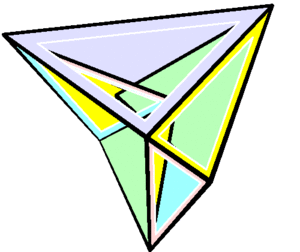In geometry, Steffen's polyhedron is a flexible polyhedron discovered (in 1978[1]) by and named after Klaus Steffen. It is based on the Bricard octahedron, but unlike the Bricard octahedron its surface does not cross itself.[2] It has nine vertices, 21 edges, and 14 triangular faces.[3] Its faces can be decomposed into three subsets: two six-triangle-patches from a Bricard octahedron, and two more triangles (the central two triangles of the net shown in the illustration) that link these patches together.[4]


It obeys the strong bellows conjecture, meaning that (like the Bricard octahedron on which it is based) its Dehn invariant stays constant as it flexes.[5]
Although it has been claimed to be the simplest possible flexible polyhedron without self-crossings,[3] a 2024 preprint by Gallet et al. claims to construct a simpler non-self-crossing flexible polyhedron with only eight vertices.[6]
References
edit- ^ Optimizing the Steffen flexible polyhedron Lijingjiao et al. 2015
- ^ Connelly, Robert (1981), "Flexing surfaces", in Klarner, David A. (ed.), The Mathematical Gardner, Springer, pp. 79–89, doi:10.1007/978-1-4684-6686-7_10, ISBN 978-1-4684-6688-1.
- ^ a b Demaine, Erik D.; O'Rourke, Joseph (2007), "23.2 Flexible polyhedra", Geometric Folding Algorithms: Linkages, origami, polyhedra, Cambridge University Press, Cambridge, pp. 345–348, doi:10.1017/CBO9780511735172, ISBN 978-0-521-85757-4, MR 2354878.
- ^ Fuchs, Dmitry; Tabachnikov, Serge (2007), Mathematical Omnibus: Thirty lectures on classic mathematics, Providence, RI: American Mathematical Society, p. 354, doi:10.1090/mbk/046, ISBN 978-0-8218-4316-1, MR 2350979.
- ^ Alexandrov, Victor (2010), "The Dehn invariants of the Bricard octahedra", Journal of Geometry, 99 (1–2): 1–13, arXiv:0901.2989, doi:10.1007/s00022-011-0061-7, MR 2823098.
- ^ Gallet, Matteo; Grasegger, Georg; Legerský, Jan; Schicho, Josef (October 17, 2024), Pentagonal bipyramids lead to the smallest flexible embedded polyhedron, arXiv:2410.13811